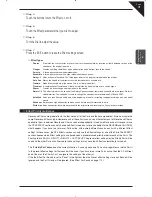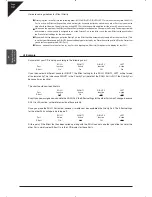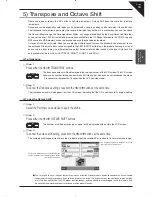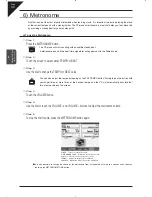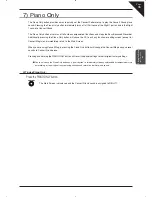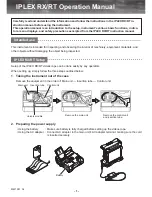
Page
31
3
Pla
ying the Piano
(Basic Controls)
Step 4
Touch the buttons to turn the Effect on or off.
Step 5
Touch the Effect paramaters that you wish to adjust.
Step 6
Turn the Dial to adjust the value.
Step 7
Press the EXIT button to leave the Effect settings screen.
Effect Types
Chorus
Simulates the rich character of a vocal choir or string ensemble, by layering a slightly detuned version of the
sound over the original to enrich it.
Flanger
Creates a shifting comb-filter, which adds motion and a “hollow” tone to the sound.
Celeste
A three-phase chorus without modulation.
Ensemble
A three-phase chorus with a slight modulation to each phase.
Delay 1-3
Adds echoes to the sound. The three types differ in the length of time between the echoes.
Auto Pan
Moves the sound left and right across the stereo field at a variable rate.
Tremolo
Modulates the volume of the sound. This is a vibrato type effect.
Tremulant
A combination of Tremolo and Vibrato. It simulates the tremulant pipes of a church organ.
Phaser
Creates a phase change, adding motion to the sound.
Rotary 1-2
This effect simulates the sound of the Rotary Speaker cabinet commonly used with electric organs. Rotary 2
adds distortion. The soft pedal is used to change the speed of the rotor between SLOW and FAST.
Auto Wah
Sweeps a tone filter up and down at the beginning of a note, recreating the popular vintage wah wah pedal
sound.
Enhancer
Emphasizes high frequencies to make a sound more easily discernible in a mix.
Distortion
Adds frequencies that were not present in the original sound, resulting in a “fuzzy” or warmer tone.
Effect Priority Guidelines
Reverb and Chorus are global effects. In other words, all of the Parts and the Accompaniment Style must share the
same Reverb and Chorus type. However each of these Parts can have a different amount of Reverb and Chorus
applied to them. In addition Reverb and Chorus can be independently turned on/off for each part. However, since
the CP’s EFFECT section can only have one Effect turned on at a time (in addition to the REVERB and CHORUS),
what happens if you have two (or more) Parts active, with entirely different sounds, each with a different Effect
setting? In these cases, the CP’s Effects section can only use the Effect settings for one of the Parts. The EFFECT
section chooses which Effect settings to use based upon a predetermined priority order for each of the Parts. The
Priority order is SOLO > RIGHT 1> RIGHT 2 > LEFT/SPLIT. The preset effect settings for the Priority Part will be
used and the other Parts will either share these settings or may have their Effects automatically turned off.
This “
Priority Part
” depends on the current situation. If you only have one Part active, regardless of which Part it
is, the preset effect settings for that sound will be used. If you have two or more Parts active, then the CP will treat
one of them as the Priority Part, and ignore the settings of the other(s).
If the the Effect For Sound is set to “Panel” in the System then the Preset effect settings for each Sound will be
ignored and the Part Priority will be ignored. (See Effect For Sound on page 112).
Summary of Contents for Concert Performer CP139
Page 1: ...1 OVERVIEW OF CONTROLS 2 SOUNDS 3 STYLES 4 RECORDER 5 USB USAGE Quick Start Guide ...
Page 2: ......
Page 38: ...Page 38 USER NOTES ...
Page 39: ...Page 39 ...
Page 42: ...All descriptions and specifications in this manual are subject to change without notice ...
Page 217: ...Page 177 11 Appendices User Notes ...
Page 218: ......
Page 219: ......















